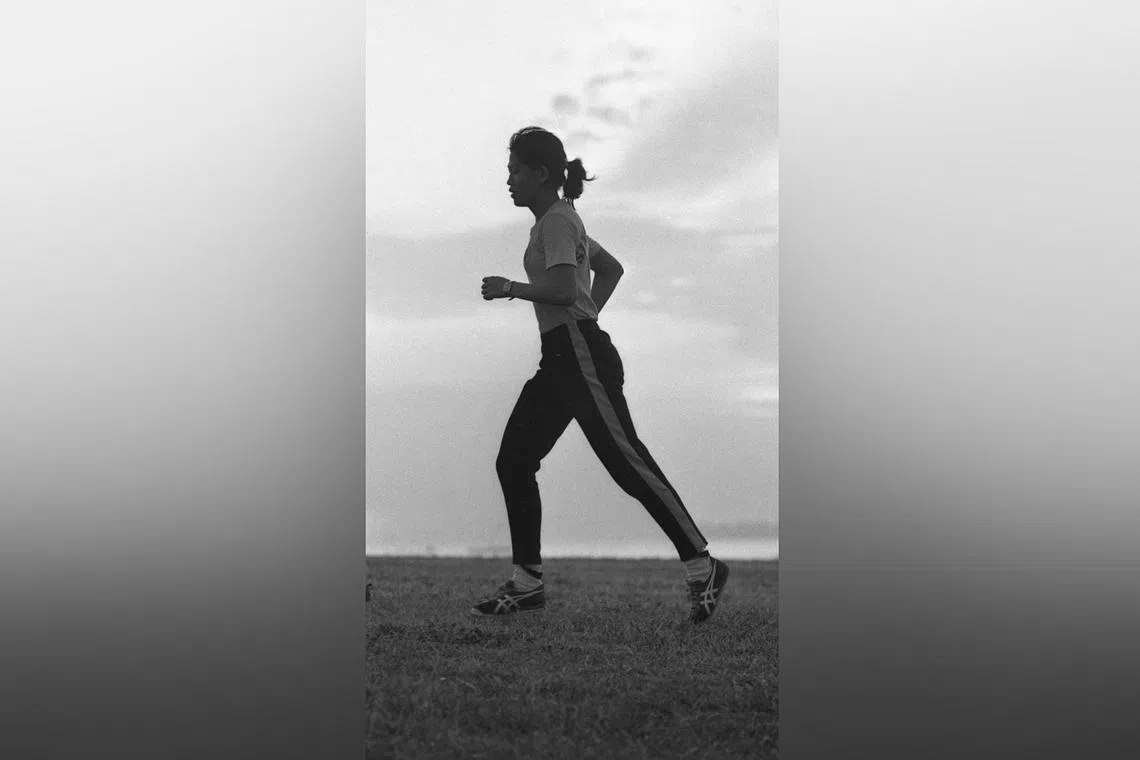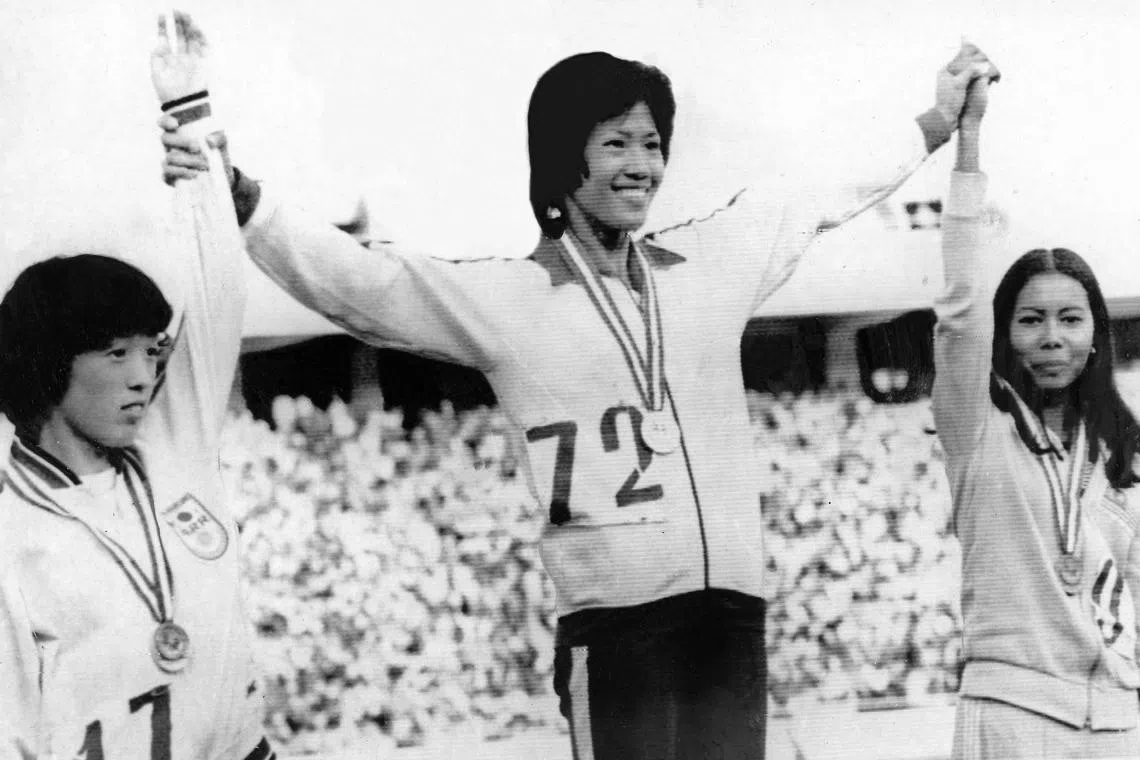A woman with small shoes who left a big footprint
In Las Vegas, a 68-year-old real estate agent holds a unique piece of Singapore history. In 18 Asian Games since 1951, Chee Swee Lee, the 400m runner, is the only Singaporean woman to win a gold in track and field.
Sign up now: Get the biggest sports news in your inbox

Chee Swee Lee, the 400m champion, training at the East Coast Lagoon in 1976.
ST PHOTO: YOW YUN WOH
Follow topic:
Heroes wrinkle. Youth flees. Shoes gather dust. Memories fade. But one thing remains forever. The epics they write.
In the Mojave Desert in America lives a Singaporean woman who wears small shoes (size 5, Euro) but left an epic footprint on history. A woman who sells fine homes in Las Vegas, a place where they possibly don’t know who she is. Don’t know about her famous lunch breaks. Don’t know this 68-year-old is the greatest female track athlete Singapore has produced.
If they asked Chee Swee Lee, what a story she would tell. About a long time ago when she dealt with a different sort of real estate. A piece of circular land which was priceless. Land that couldn’t be bought, but with uncommon talent could be conquered.
Her land was the 400m track, which on one brilliant September day in 1974 became her property. At the Asian Games in Teheran, Chee ran around this oval in an Asian record of 55.08 seconds to win gold. In 18 Games since 1951, only one other Singaporean – Ng Liang Chiang in the men’s 110m hurdles in 1951 – has won track and field gold.
Footprints matter for they are proof of where a nation has been. They become an inspiration and turn into a challenge. As the Asian Games approaches, among other things, Shanti Pereira will be chasing the legend of Chee.
“The thrill” of track and field, Chee wrote to me, was the uniqueness of her competition: Her, alone, against rivals and a clock. As a young runner she had moderate success in the 100m and 200m before her coach Patrick Zehnder convinced her she could excel at the 400m. Now she says, “my real estate business cards include the tag line ‘Going The Extra Mile For You’ and that is my own secret reference to the leap from the sprints to the 400m in order to achieve optimal results”.
Footprints are a dent made in time and they require exceptional drive. C. Kunalan, the sprinter who’s known Chee for 50 years, says, “She was just a very polite person. The impressive part was her ability to train hard.”
How hard? Listen to her lunch-break story.
“In 1972,”, she says, “I was working at the National Sports Promotion Board (NSPB). At that time, the major mission statement involved ‘sports for excellence’... As a concession to me based on my performance level... I was released from work duties one hour early to go train.”
When, she says, the NSPB merged with the Singapore Sports Council and “sports for all” became the new mission statement, the emphasis shifted “to the health and fitness of the population at large. As a result, my one-hour training concession was revoked”.
“I therefore tried to find that training time during the workday and that is how my 10-minute lunch breaks came to be.” Ten minutes to eat, the rest for “circuit weight training”.
Footprints come from perseverance, quick eating and hard off-seasons. Like 20 x 200m repetitions with one-minute rest. Or 10 x 400m some days with two minutes rest. Or her three-four mile early morning runs before work.
In her 1970s world there were no altitude rooms and ice baths. Just work ethic and an exceptional coach. Zehnder, in Chee’s words, “read widely and stayed current with the latest coaching techniques and innovations”.
All this persistence mattered for the 400m is a cruel race. John Regis, the 200m world indoor champion in 1989, wrote in The Guardian: “I was scared of the 400m... I would get to 300 and it would feel as if my whole body was on fire.” Chee describes it as “extremely difficult. During my era, many female sprinters were unwilling to take it on”.
The day of her great footprint is immortalised in footage you can find on YouTube. Its beauty lies in the final 50m when she unfolds her wings and flies. It’s so impressive, I had to ask: Were you famous for your strong finishes?
“I was known for it”.

Chee Swee Lee on the podium with her gold medal during the Asian Games in 1974 in Tehran.
PHOTO: ST FILE
Then she said, “when the ‘bear jumped on me’ in the home stretch” she was ready.
Bear?
“It is a cute but highly descriptive term (picked up by her in the US) regarding the excruciating leg pain, shortness of breath, fatigue, and overall exhaustion experienced by all 400m runners somewhere near the final 100 metres of the race due to lactic acid build-up.
“It is quite unpleasant and comes on very suddenly, literally as though a large bear had jumped on your back towards the end of the race when you need the most energy.”
Athletes have their own inner beast and she fought the bear, she won, and now her medal lies in the Singapore Sports Museum. But her gift to Singapore isn’t that round piece of metal or the pair of her shoes next to it. It’s the footprints she left with them.
Footprints that symbolise excellence. Footprints that show her nation the way.


